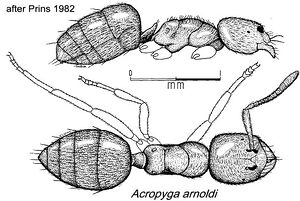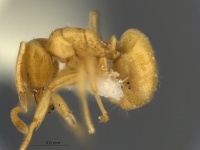Acropyga arnoldi
| Acropyga arnoldi | |
|---|---|

| |
| Scientific classification | |
| Kingdom: | Animalia |
| Phylum: | Arthropoda |
| Class: | Insecta |
| Order: | Hymenoptera |
| Family: | Formicidae |
| Subfamily: | Formicinae |
| Tribe: | Plagiolepidini |
| Genus: | Acropyga |
| Species group: | arnoldi |
| Species: | A. arnoldi |
| Binomial name | |
| Acropyga arnoldi Santschi, 1926 | |
| Synonyms | |
| |
Lapolla (2004) - This species is known to tend the mealybug Eumyrmococcus scorpiodes (see De Lotto, 1977 for more details) and has trophophoretic queens (Prins, 1982). Alates have been collected from March to July. Prins (1982) discovered trophophoretic queens in July. A. arnoldi has been found in a variety of habitats throughout southern Africa from deserts to woodlands.
Identification
LaPolla (2004) - The only member of the Acropyga arnoldi species group. Worker: 11 segmented antennae; mandible broad with 6-9 uneven teeth; mesosoma noticeably covered in a thick layer of long appressed hairs. Queen: as in worker with modifications expected for caste. Male: 12 segmented antennae; mandible broad with 5-6 teeth; parameres broadly rounded at apex. Compare with Acropyga paleartica and Acropyga silvestrii.
This species is easy to recognize from other Acropyga by its broad, many-toothed mandible (at least 6 teeth and up to 9) and by the 5 to 4 segmented maxillary palps. It is the only Acropyga known from southern Africa. The combination of high number of mandibular teeth and high number of maxillary palpal segments suggests that this species is primitive.
The other African species, Acropyga silvestrii has up to 7 teeth, but its palp formula is never greater than 3:3, and it is known to have antennal segment counts as low as 10 (possibly indicative of belonging to a more derived group). Acropyga paleartica has been observed with up to 8 mandibular teeth, and possesses a 5:3 palp formula. The relationship of A. arnoldi to A. paleartica and A. silvestrii is unclear since those two species await discovery of males. Interestingly, the mealybug utilized by A. paleartica (Eumyrmoccus corinthiacus) is thought to be closely related to the mealybug species utilized by A. arnoldi (Williams, 1998).
Keys including this Species
Distribution
Latitudinal Distribution Pattern
Latitudinal Range: -20.16667° to -34.70812°.
| North Temperate |
North Subtropical |
Tropical | South Subtropical |
South Temperate |
- Source: AntMaps
Distribution based on Regional Taxon Lists
Afrotropical Region: Central African Republic, Namibia, South Africa (type locality), Zimbabwe.
LaPolla (2004) - This species range is throughout southern Africa (roughly defined as the area south of the Zambezi River). The exact northern limit of A. arnoldi is unclear, however, it does not appear to overlap with the other described African species Acropyga silvestrii, which is known to extend at least into northern Tanzania.
Distribution based on AntMaps
Distribution based on AntWeb specimens
Check data from AntWeb
Countries Occupied
| Number of countries occupied by this species based on AntWiki Regional Taxon Lists. In general, fewer countries occupied indicates a narrower range, while more countries indicates a more widespread species. |

|
Estimated Abundance
| Relative abundance based on number of AntMaps records per species (this species within the purple bar). Fewer records (to the left) indicates a less abundant/encountered species while more records (to the right) indicates more abundant/encountered species. |

|
Biology
Association with Other Organisms
 Explore: Show all Associate data or Search these data. See also a list of all data tables or learn how data is managed.
Explore: Show all Associate data or Search these data. See also a list of all data tables or learn how data is managed.
This species is a mutualist for the mealybug Eumyrmococcus scorpioides (a trophobiont) in Africa (Prins, 1982; LaPolla & Spearman, 2007; Schneider & LaPolla, 2020).
Morphology
Castes
worker

| |
| . | |
Phylogeny
| Acropyga |
| ||||||||||||||||||||||||||||||||||||||||||||||||||||||||||||||||||||||||||||||||||||||||||||||||||||||||||||||||||||||||||||||
Based on Blaimer et al., 2016. Note only selected Acropyga species are included, and undescribed species are excluded.
Nomenclature
The following information is derived from Barry Bolton's Online Catalogue of the Ants of the World.
- arnoldi. Acropyga (Malacomyrma) arnoldi Santschi, 1926b: 245 (w.q.) SOUTH AFRICA.
- Prins, 1982: 245 (m.).
- Status as species: Prins, 1982: 238 (redescription); Bolton, 1995b: 57; LaPolla, 2004a: 35 (redescription); LaPolla & Fisher, 2005: 605 (in key).
- Senior synonym of rhodesiana: Prins, 1982: 238; Bolton, 1995b: 57; LaPolla, 2004a: 35.
- rhodesiana. Acropyga (Malacomyrma) rhodesiana Santschi, 1928f: 211 (w.) ZIMBABWE.
- Junior synonym of arnoldi: Prins, 1982: 238; Bolton, 1995b: 58; LaPolla, 2004a: 35.
Unless otherwise noted the text for the remainder of this section is reported from the publication that includes the original description.
Description
Worker
LaPolla (2004) - (n=6): TL: 2. 13-2.4; HW: 0.517-0.619; HL: 0.634-0.705; SL: 0.466-0.575; ML: 0.686-0.735; GL: 0.81-1.02; CI: 80.99-92.80; SI: 83.77-100.70.
Head: yellow to brownish-yellow; head distinctly longer than broad; covered in a layer of short appressed hairs; posterior margin entire to concave; 11 segmented, incrassate antennae; scape reaches to posterior margin; clypeus convex medially; covered in a layer of appressed to erect hairs; mandible broad, with 6-9 uneven teeth; 3rd tooth and 5th tooth often shorter than other teeth; dorsal surface of mandible with many hairs (approximately 20); anterior clypeal margin and inner mandibular margin nearly parallel. Mesosoma: yellow to brownish-yellow; in lateral view, pronotum with a short anterior shelf before rising toward mesonotum; pronotum rounded posteriorly; covered in a thick layer of long appressed hairs, with erect hairs often found along posterior border of segment; mesonotum rounded, slightly higher than propodeum, covered in a thick layer of long appressed hairs; metanotal area distinct; propodeum rounded, covered in a thick layer of long appressed hairs; declivity steep. Gaster: petiole erect and broad, with a rounded apex covered in erect hairs; gaster yellow to brownish-yellow; covered in a layer of appressed hairs with suberect to erect hairs scattered throughout, particularly along segmental margins.
Queen
LaPolla (2004) - (n=l): TL: 4.32; HW: 0.826; HL: 0.804; SL: 0.721; ML: 1.07; GL: 2.45; CI: 102.74; SI: 87.29. As in worker with modifications expected for caste and with the following differences: mesosomal appressed hairs shorter than in worker; mesoscutellum with several erect hairs.
Male
LaPolla (2004) - (n=l): TL: 3.2; HW: 0.487; HL: 0.487; SL: 0.549; ML: 0.946; GL: 1.77; CI: 100; SI: 112.73.
Head: brownish-yellow to brown toward apex around 3 prominent ocelli; head slightly longer than broad; eyes large taking up most of lateral sides, breaking outline of head in full frontal view; 12 segmented antennae; scape long, surpassing posterior margin by at least the length of the 1st two funicular segments; clypeus slightly convex, rounded medially; with many erect hairs on surface; mandible broad as in worker with 5-6 uneven teeth. Mesosoma: yellow to brownish-yellow; pronotum collar-like, with rounded mesonotum above; covered in a layer of short appressed hairs; mesonotum rounded anteriorly, covered in a thick layer of short appressed hairs; mesonotum and higher than propodeum; declivity steep, with layer of short appressed hairs. Gaster: petiole erect and short, not reaching height of propodeum; petiole apex rounded; gaster yellow to brownish-yellow; covered in a layer of appressed hairs, with scattered erect hairs along segmental margins. Genitalia: in lateral view, parameres broadly rounded at apices; base of parameres without hairs; dorsally parameres broadly extend laterally, largely concealing digiti and cuspi from view; cuspi short and cylindrical, apically with short, peg-like teeth; digiti long, bent toward cuspi; digiti and cuspi meet apically; apex of digiti truncated, with short, peg-like teeth.
Type Material
La Polla (2004):
Acropyga (Malacomyrma) arnoldi Santschi, 1926: 245 (w.q.). 7 syntype workers, 1 syntype queen, SOUTH AFRICA: Durban (C.P. Merre) Museum of Comparative Zoology, Naturhistorisches Museum, Basel and SAMC [examined]. The designated lectotype is a worker labeled JSL TYPE # 112 and is deposited at SAMC. The lectotype is one of three specimens flat on a card and is the worker specimen furthest from the queen specimen. Prins 1982: 245, description of male.
Acropyga (Malacomyrma) rhodesiana Santschi, 1928b: 211 (w.). 9 syntype workers, ZIMBABWE: Bulawayo, Rifle Kopie The Natural History Museum, Naturhistorisches Museum, Basel and SAMC [examined]. Synonymy by Prins, 1982: 238 (here confirmed).
References
- Devenish, A.J.M., Newton, R.J., Bridle, J.R., Gomez, C., Midgley, J.J., Sumner, S. 2021. Contrasting responses of native ant communities to invasion by an ant invader, Linepithema humile. Biological Invasions 23, 2553–2571 (doi:10.1007/s10530-021-02522-7).
- Gomez, K., Hawkes, P.G., Fisher, B.L. 2023. Ant endemicity in the highlands and escarpments of Angola and Namibia (Hymenoptera, Formicidae). Monograph on Endemism in the Highlands and Escarpments of Angola and Namibia. Namibian Journal of Environment 8, 197-203.
- LaPolla, J.S. 2004a. Acropyga of the world. Contributions of the American Entomological Institute. 33(3):1-130. (page 35, worker, queen, male described)
- Prins, A. J. 1982. Review of Anoplolepis with reference to male genitalia, and notes on Acropyga (Hymenoptera, Formicidae). Ann. S. Afr. Mus. 89:215-247. (page 238, senior synonym of rhodesiana)
- Santschi, F. 1926b. Description de nouveaux Formicides éthiopiens (IIIme partie). Rev. Zool. Afr. (Bruss.) 13:207-267. (page 245, worker, queen described)
- Schneider, S.A., LaPolla, J.S. 2020. Trophobiosis between a new species of Williamsrhizoecus (Hemiptera: Coccomorpha: Rhizoecidae) and Acropyga silvestrii (Hymenoptera: Formicidae) in Tanzania. Zootaxa 4853, 283–291 (doi:10.11646/zootaxa.4853.2.9).
References based on Global Ant Biodiversity Informatics
- IZIKO South Africa Museum Collection
- LaPolla J.S. 2004. Acropyga (Hymenoptera: Formicidae) of the world. Contributions of the American Entomological Institute 33(3): 1-130.
- Prins A. J. 1982. Review of Anoplolepis with reference to male genitalia, and notes on Acropyga (Hymenoptera, Formicidae). Annals of the South African Museum 89: 215-247.
- Robertson H. G. 2000. Formicidae (Hymenoptera: Vespoidea). Cimbebasia Memoir 9: 371-382.


